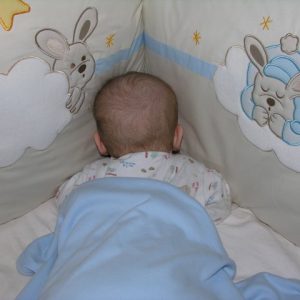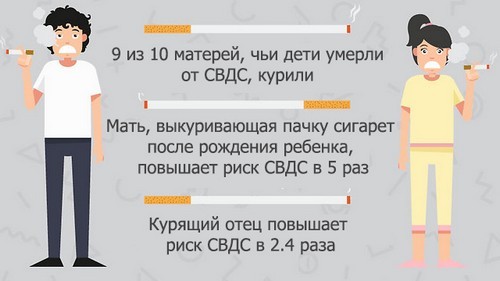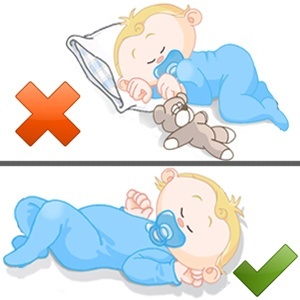Syndrome “death in the cradle”, or scientifically SIDS (sudden infant death syndrome) in young children is a post-mortem pathoanatomical conclusion, not a clinical diagnosis.
Until the death of the dream the children were made healthier, did not cause anxiety among doctors and parents, had serious malformations, birth defects, and other reasons for death.
Today there were many hypotheses to explain the origin of the syndrome, but apart from them, scientists and doctors say that more at risk to die of SIDS those children for whom reveals the influence of numerous risk factors – both external and from the side of the body, metabolic processes and nervous system.
What increases the risk of SIDS?
During many years of studying the problem of SIDS and post-mortem study of tissues and organs of dead kids, has identified factors that dramatically increases the probability of adverse outcomes in infancy with the formation of SIDS.
It is important
These effects are referred to the group of risk factors, but their presence still does not mean that your baby might die in my sleep, panic and no need to worry, but to pay attention to the preventive measures necessary.

So, increase the risks for the baby on the formation of SIDS:
- Sleep the crumbs on his tummy, especially in the crib or bed with soft collars, pillows and duvets.
- Overheat baby due to the high temperature and low air humidity, excessive wrapping, putting on hats, socks, cover up with a blanket (especially a thick, cotton) in a dream.
- The deficit of body weight at birth and a lack of recruitment in the first months.
- The factor of prematurity and immaturity crumbs, and dependent on degree. The smaller the gestational age to birth, the higher the risk, the less Mature the child to the birth, the worse the prognosis.
- Children who were born from multiple pregnancies.
- Kids born class, from the third and subsequent pregnancies.
- If in the family there were cases of SIDS among the closest relatives of the father or mother, took place earlier episodes of death of infants because of unknown reasons.
- The lack of observation of pregnancy of the mother, if she later got up on the account, did not conduct an ultrasound or other investigations.
- If the child has had recent respiratory illness, infections, and other diseases.
- The presence of anemia in mother during pregnancy, the condition of fetal hypoxia, and anemia, the baby after birth.
- The birth of the crumbs from a very young moms, under the age of 17 or after age 35-40 years.
- The presence of the mother’s bad habits before pregnancy and after her time, Smoking in the family.
- Adverse living conditions of families with child of low economic and social level, lack of basic knowledge related to infant care, crowded living conditions (dormitories, communal, poorly ventilated rooms).
- The presence of depressive disorders in the mother during gestation and after birth, and the emergence of the child from the mother alone.
Although risk factors are listed a lot, but special attention should be given to one of them, which, according to the researchers, most severely and adversely affects a child sharply increases the risk of SIDS is Smoking.
If you stop Smoking during pregnancy and at least the infancy of the crumbs, the risk of SIDS is reduced by at least 40% in comparison with Smoking families. Dangerous not only Smoking at the child, but also passive Smoking pregnant if she’s breathing tobacco smoke in the presence of family members who smoke.
Smoking is dangerous even in neighbouring and adjacent rooms, with the presence of hoods and open Windows.

Anxiety symptoms and methods to help them
Threat against SIDS may be periods of apnea in children (lack of breathing periods more than 10-15 seconds), especially repeated more times per hour.
If parents detect a sudden stop in breathing when the baby is sleeping, you must:
- Immediately take the child in his arms,
- Actively pursue fingertips in the course of the spine, directing them from the coccyx to the neck,
- To massage the earlobes, feet, handles,
- Actively stir the crumbs.
Typically, such action is sufficient to ensure that the baby did breath, and then burst into tears and through this actively razdelalsya. If a child has not started to breathe, the following sequence of actions:
- Call ambulance,
- For indirect massage of heart
- The use of artificial respiration.
It is important that parents had skills such manipulations.
Is it SIDS?
It is important to understand that SIDS is a postmortem diagnosis, performed by a process of elimination. He does not belong to the main root cause of death of infants, most often there are well-grounded and more serious causes. But sometimes, to find out all possible reasons for the death of the baby, the experts need all the card data and a generic case history, and sometimes data on the course of pregnancy, as well as information obtained from parents. Only if you exclude all possible influences and prosperous during pregnancy, childbirth and infancy is SIDS. What can hide under the mask of SIDS?
Abuse of children and domestic violence
How would it not seem strange, but this factor leads the list of deaths of infants under the guise of SIDS. Often death may be the result of outbursts of the mother or father, the ill-treatment of child or leaving him in danger. Such episodes in today’s time ceased to be a rarity. And if this is a serious fractures or internal injuries, which experts discover not hard, some of the manifestations at once cannot figure out – it was a deliberate strangulation of children or “shaken baby syndrome”. Both these conditions – the result of child abuse.
If the child is severely shaking while rocking sharply shake or toss the big weight of a head against the immature neck muscles and weak vertebrae can predispose to serious injuries of the brain, especially in its stem portion, with the development of coma and death.
Especially suspicious violent death will become asocial families or repeated episodes of death of children.
Unintentional asphyxia (prisypanija baby)
This is the death of a child as the result of crushing by the mother’s body, bedding in a joint sleep amid the sleepless nights, extreme fatigue and hormonal changes, when practiced breastfeeding and co-sleeping. If the fatigue of the mother without adequate assistance and support reached a certain point, it can so hard to fall asleep, he did not notice the problem of the crumbs and accidentally crushed his body.
If old mother in his normal state will immediately Wake up the wiggling, screaming or groaning child, on a background of reception of alcohol or sleeping pills, her brain may be disconnected.
In this regard, there is much debate about the feasibility of a joint dream mother with a baby in HS, but in fairness it should be noted that the development of SIDS is not less likely, and when the baby sleep in a separate bed.
Viral infection and microbial nature
Can cause the death of infants latent infection with microbial or viral origin. In the incubation period, no clinical symptoms, while the negative impact of pathogenic microorganisms and their toxins is likely. Also possible death due to atypical development or fulminant disease, especially in premature infants and immature children who may not have clinical manifestations. It was important to exclude meningitis, and a variety of other lesions that can be lethal.
Co-sleep if he’s dangerous to the development of SIDS?
Disputes in respect of a joint dream mother, breastfeeding, and baby being long, they are relevant in connection with the opportunity to “prismati” of the child with the development of accidental asphyxia. But experts in the field of the GW, the physiology of children and mothers talking about the fact that the mother, not susceptible to depression, alcohol intoxication or under the influence of drugs, flatten and “prismati” the child can not. This is due to the fact that work maternal instincts and formed a light sleep with the immediate reaction of the awakening movement, squeaking, shouting, groaning, and even change the baby’s breath.

Moreover, co-sleeping helps in the longer GW, which relates to the prevention of SIDS by 20-25% reduces the risk of SIDS, because the baby sinhroniziruete their rhythms of breath and heartbeat with the mother, and the mother feels the little “brain and heart”.
Mom, even in her sleep, and half asleep, sensitively monitors the status of crumbs, and the least of his concern leads to the fact that it turns over or applies to the breast, thereby stimulating his breath.
It is believed that the risk of SIDS occurs in children after a period of loud and prolonged crying in his crib when it is not appropriate, and from fatigue and excitement, he then falls into a period of deep heavy sleep.
When sharing a dream such episodes are excluded, the mother will not allow the child to cry hysterically.
Type-feeding and the risk of SIDS
According to numerous publications have proved the importance of guards to prevent SIDS, as the waiver period of the first month, increases the risk of death more than 5 times, and feeding for two months – 3.5 times. If practiced mixed feeding, the risks do not exceed the average. Breast milk due to its composition of fatty acids and protective immunoglobulins accelerates the maturation of brain structures, helps in protection against infections, protecting baby from breathing disorders.
Influence of swaddling on SIDS
In relation to swaddling, especially tight, expert opinions in forecasting risk of SIDS diverge. So, some of them say that tight swaddling does not allow the child to roll over in my sleep, and reduced risk of nakryvanie head with a blanket or uticaria face in the pillows, which reduces the risk of SIDS. But, at the same time, other experts say that swaddling and limitation of motion of crumbs does not make a comfortable position for sleep, disrupts thermoregulation and in danger of overheating, may interfere with breathing due to compression of the chest and increases the risks of SIDS.

Pacifiers and the risk of SIDS
Although in relation to pacifiers for infants experts Express the opinion of its uselessness, but for those kids who are fed with formula and sleeps in the crib, she can be saved from SIDS. So, holes in the product ensure the access of air to the child, even when you turn on your stomach, if the baby buried her face in the bed or if the blanket he had covered her head. It is recommended to apply iskusstvennym from the age of 1 month, and then gradually removed by the age of one year, when the risk of SIDS is already reduced. Infants as an alternative of the dummy should be the mother’s breast.
How to prevent sudden infant death syndrome
It is impossible to predict in advance of such condition and prevent it in all cases, so for parents, the priority must be the prevention of SIDS. They include creating a safe environment and avoid those risk factors that they can influence.

First of all, it is important to ensure adequate conditions for sleeping child:
- Children should sleep on their back or side, but at the appropriate position lying on the belly they can sleep under the supervision of parents or creating a special situation.
- Bedding should not be too soft and prodavlivanija prohibited soft feather beds and cotton mattresses, under one year do not need pillows.
- It is not necessary to cover the children with blankets, it is better to dress warmer and to give the possibility to sleep without them.
- Not worth tight to swaddle children to sleep, restless kids can preparati arms and legs freely.
- In the crib do not place soft toys and different things.
Not less important and microclimate in the house, do not allow freezing as well as overheating of the baby hats at home at room temperature is only needed after bathing, while the hair dries out and only at an early age. The optimum temperature for sleep is 18-200C. If the child just ate before going to bed, you need to burp the air, this is achieved by wearing it on hand column, to discharge air with a typical sound.
Permitted use of various devices and monitors, especially if the baby asleep in his crib and separate room. They will inform parents about sleep disorders, and breathing and anxiety.
But modern wedges and positioners for sleeping, which are touted as ways to prevent SIDS, inefficient, expensive and useless, and in some cases can be even dangerous (do not allow to take a comfortable physiological posture for sleep).
Also not proven to increase risk of SIDS when carrying out vaccination, large-scale scientific studies have not found such regularities, therefore you should not refuse vaccination for this reason.
There is a group of children for whom it is important to pay special attention to reduce the risks of SIDS:
- Children with high temperatures, including during sleep
- Kids with reduced physical activity, refusing food, developing symptoms of an ailment
- Kids with symptoms of any respiratory conditions – cough, cold symptoms’s snoring noise
- Sleeping after long periods of crying or tantrums
- Forced to spend the night in an unfamiliar situation for them, and not in his crib.
For these children the parents need to establish greater control over day dreams, and night.



